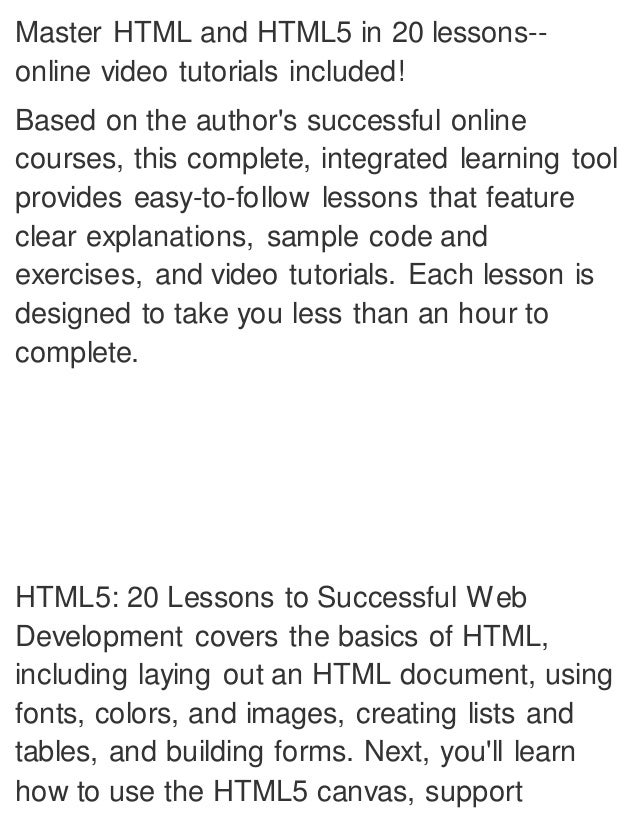Html5 Web Author Edition
HTML5: Edition for Web Authors. HTML5: Edition for Web Authors Publication History. For the current relationship of this specification to others.
HTML5: Edition for Web Authors W3C Working Draft 09 August 2011 This Version: Latest Published Version: Latest Editor's Draft: Editor:, Google, Inc. This specification is available in the following formats:,. This is revision 1.4938. © 2011 ® (, ), All Rights Reserved.
W3C, and rules apply. The bulk of the text of this specification is also available in the WHATWG specification, under a license that permits reuse of the specification text. Abstract This document is a strict subset of the that omits user-agent (UA) implementation details. It is targeted toward Web authors and others who are not UA implementors and who want a view of the HTML specification that focuses more precisely on details relevant to using the HTML language to create Web documents and Web applications.
Because this document does not provide implementation conformance criteria, UA implementors should not rely on it, but should instead refer to the. This document is an automated redaction of the. As such, the two documents are supposed to agree on normative matters concerning Web authors. However, if the documents disagree, this is a bug in the redaction process and the unredacted full HTML specification takes precedence. Readers are encouraged to report such discrepancies as bugs in the bug tracking system of the HTML Working Group.
Status of This document This section describes the status of this document at the time of its publication. Other documents may supersede this document. A list of current W3C publications and the latest revision of this technical report can be found in the at If you wish to make comments regarding this document in a manner that is tracked by the W3C, please submit them via using. If you do not have an account then you can enter feedback using this form: Feedback Comments Please enter your feedback, carefully indicating the title of the section for which you are submitting feedback, quoting the text that's wrong today if appropriate. If you're suggesting a new feature, it's really important to say what the problem you're trying to solve is. That's more important than the solution, in fact.
Please don't use section numbers as these tend to change rapidly and make your feedback harder to understand. (Note: Your IP address and user agent will be publicly recorded for spam prevention purposes.) If you cannot do this then you can also e-mail feedback to (, ), and arrangements will be made to transpose the comments to our public bug database. Alternatively, you can e-mail feedback to (, ). The editor guarantees that all substantive feedback sent to this list will receive a reply. However, such feedback is not considered formal feedback for the W3C process.
All feedback is welcome. The working groups maintains and. The editor also maintains. These bugs, issues, and e-mails apply to multiple HTML-related specifications, not just this one.
Implementors should be aware that this specification is not stable. Implementors who are not taking part in the discussions are likely to find the specification changing out from under them in incompatible ways. Vendors interested in implementing this specification before it eventually reaches the Candidate Recommendation stage should join the aforementioned mailing lists and take part in the discussions. The publication of this document by the W3C as a W3C First Public Working Draft does not imply that all of the participants in the W3C HTML working group endorse the contents of the specification.
Indeed, for any section of the specification, one can usually find many members of the working group or of the W3C as a whole who object strongly to the current text, the existence of the section at all, or the idea that the working group should even spend time discussing the concept of that section. A number of are open against this document:. The HTML Working Group chairs maintain a; that list may change as this document progresses. There are also a number of related to this document, for which working-group decisions still need to be made:.
The HTML Working Group chairs maintain a; that list may change as this document progresses. Activities are being pursued by some members of the HTML Working Group to provide related to this document, with the intent of reopening the following issues:. The HTML Working Group chairs maintain a; that list may change as this document progresses.

A list of other potential is also available. W3C anticipates that there will be changes to this specification as a result of the resolution of Last Call issues. Per the usual W3C Process, any significant changes to the specification will trigger a subsequent Last Call.

The latest stable version of the editor's draft of the full HTML5 specification is always available on and in the. The (which may contain unfinished text in the process of being prepared) contains the latest draft text of this specification (amongst others). For more details, please see the.
Encpt Web Author
There are various ways to follow the change history for the HTML specifications: E-mail notifications of changes HTML-Diffs mailing list (diff-marked HTML versions for each change): Commit-Watchers mailing list (complete source diffs): Browsable version-control record of all changes: CVSWeb interface with side-by-side diffs: Annotated summary with unified diffs: Raw Subversion interface: svn checkout The W3C is the W3C working group responsible for this specification's progress along the W3C Recommendation track. This specification is the 07 July 2011 First Public Working Draft. Work on this specification is also done at the.
Html5 Web Templates
The W3C HTML working group actively pursues convergence with the WHATWG, as required by the. This document was produced by a group operating under the. W3C maintains a made in connection with the deliverables of the group; that page also includes instructions for disclosing a patent. An individual who has actual knowledge of a patent which the individual believes contains must disclose the information in accordance with.